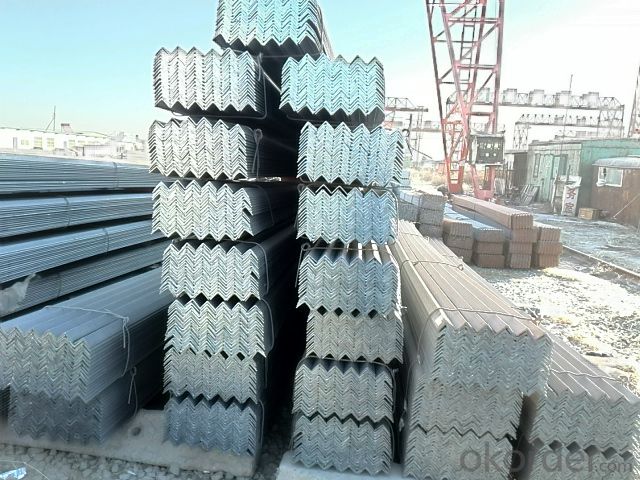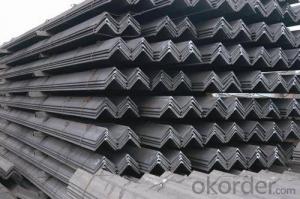Hot Rolled Equal Angle steel with high quality
- Loading Port:
- Tianjin
- Payment Terms:
- TT OR LC
- Min Order Qty:
- 25 m.t
- Supply Capability:
- 10000 m.t/month
OKorder Service Pledge
OKorder Financial Service
You Might Also Like
Item specifice
Okorder.com is a professional materials & equipment supplier & manufacturer, offers integrated one-stop services including real-time quoting and online cargo tracking. We are funded by CNBM Group, a Fortune 500 enterprise and the largest materials & equipment firm in China.
Product Applications:
According to the needs of different structures, Angle can compose to different force support component, and also can be the connections between components. It is widely used in various building structures and engineering structures such as roof beams, bridges, transmission towers, hoisting machinery and transport machinery, ships, industrial furnaces, reaction tower, container frame and warehouse etc.
Product Advantages:
OKorder's Steel Angles are durable, strong, and resist corrosion.
Main Product Features:
· Premium quality
· Prompt delivery & seaworthy packing (30-45 days after receiving deposit)
· Corrosion resistance
· Can be recycled and reused
· Mill test certification
· Professional Service
· Competitive pricing
Product Specifications:
1. Invoicing on theoretical weight or actual weight as customer request
2. Length: 6m, 9m, 12m as following table
3. Sizes

Sizes: 25mm-250mm | ||
a*t | ||
25*2.5-4.0 | 70*6.0-9.0 | 130*9.0-15 |
30*2.5-6.6 | 75*6.0-9.0 | 140*10-14 |
36*3.0-5.0 | 80*5.0-10 | 150*10-20 |
38*2.3-6.0 | 90*7.0-10 | 160*10-16 |
40*3.0-5.0 | 100*6.0-12 | 175*12-15 |
45*4.0-6.0 | 110*8.0-10 | 180*12-18 |
50*4.0-6.0 | 120*6.0-15 | 200*14-25 |
60*4.0-8.0 | 125*8.0-14 | 250*25 |
4.Material details:
Alloy No | Grade | Element (%) | |||||
C | Mn | S | P | Si | |||
Q235 | B | 0.12—0.20 | 0.3—0.7 | ≤0.045 | ≤0.045 | ≤0.3 | |
Alloy No | Grade | Yielding strength point( Mpa) | |||||
Thickness (mm) | |||||||
≤16 | >16--40 | >40--60 | >60--100 | ||||
≥ | |||||||
Q235 | B | 235 | 225 | 215 | 205 | ||
Alloy No | Grade | Tensile strength (Mpa) | Elongation after fracture (%) | ||||
Thickness (mm) | |||||||
≤16 | >16--40 | >40--60 | >60--100 | ||||
≥ | |||||||
Q235 | B | 375--500 | 26 | 25 | 24 | 23 | |
FAQ:
Q1: Why buy Materials & Equipment from OKorder.com?
A1: All products are carefully selected from China's most reliable manufacturing enterprises. Through its ISO certifications, OKorder.com adheres to the highest standards and a commitment to supply chain safety and customer satisfaction. We can guarantee the quality!
Q2: The products are invoicing on theoretical weight or on actual weight?
A2: We can do it in both manners, it’s according to buyer's requirement.
Q3: Can fit in the containers of 20fts for 6M long ?
A3: Yes, we can put them into the containers in the form sideling, in this way we can save the buyer much ocean freight.
Images:


- Q:What are the limitations of using steel angles?
- One limitation of using steel angles is their susceptibility to corrosion. Without proper maintenance and protective coatings, steel angles can rust over time, compromising their structural integrity. Additionally, steel angles have weight limitations and may not be suitable for heavy load-bearing applications. Finally, steel angles are limited in terms of design flexibility compared to other materials, as they are typically available in standard sizes and shapes.
- Q:Can steel angles be used as supports for mechanical or HVAC ducts?
- Yes, steel angles can be used as supports for mechanical or HVAC ducts. Steel angles provide a strong and durable framework to securely hold and provide stability to the ductwork.
- Q:Can steel angles be used in staircases?
- Yes, steel angles can be used in staircases. Steel angles are commonly used as structural elements in construction due to their strength and versatility. In staircases, steel angles can be used to provide support and stability to the steps and handrails. They are often used as stringers, which are the inclined structural members that support the treads and risers of the staircase. Steel angles can also be used to reinforce the connections between the treads and risers, ensuring the structural integrity of the staircase. Additionally, steel angles can be used as handrails or balusters, providing a secure and durable railing system. Overall, steel angles offer a reliable and cost-effective solution for constructing staircases that can withstand heavy loads and meet the necessary safety standards.
- Q:Can steel angles be used for platform structures?
- Yes, steel angles can be used for platform structures. Steel angles are commonly used in construction for their strength, durability, and versatility. They provide structural support and stability to various types of platforms, including elevated walkways, mezzanines, catwalks, and scaffolding. Steel angles offer excellent load-bearing capacity and can withstand heavy loads, making them suitable for platform structures that require a high level of strength and stability. Additionally, steel angles can be easily fabricated and joined together, allowing for efficient construction and customization of platform structures.
- Q:What are the different types of steel angles used in architectural façade systems?
- There are several different types of steel angles that are commonly used in architectural façade systems. These angles serve various purposes and are chosen based on the specific requirements of the project. 1) L-Angles: L-angles are one of the most commonly used types of steel angles in façade systems. They have a 90-degree angle and are often used to create the framework for curtain wall systems. L-angles provide structural support and stability to the façade while also allowing for the attachment of various cladding materials. 2) Z-Angles: Z-angles, also known as Z-bars, are another type of steel angle used in façade systems. They have a Z-shaped profile, with two flanges that are parallel to each other. Z-angles are often used to create horizontal or vertical support members in curtain wall systems, providing additional strength and rigidity. 3) C-Angles: C-angles, also called C-channels or C-beams, are widely used in façade systems for their versatility and strength. They have a C-shaped profile, with a wide base and two flanges that are perpendicular to each other. C-angles are commonly used as support members for cladding panels or as framing elements for architectural features like canopies or sunshades. 4) T-Angles: T-angles, also known as T-bars, have a T-shaped profile and are used in façade systems for various purposes. They can be used as support members for cladding panels, providing a stable base for attachment. T-angles are also used to create mullions or transoms in curtain wall systems, allowing for the integration of windows or glazing units. 5) Unequal Angles: Unequal angles, as the name suggests, have unequal leg lengths. They are used in façade systems when there is a need for uneven or specialized support. Unequal angles are often used to create custom shapes or profiles, allowing architects and designers to achieve unique aesthetic effects or accommodate specific project requirements. Each type of steel angle has its own advantages and applications in architectural façade systems. The choice of angle will depend on factors such as structural requirements, design considerations, and the specific needs of the project.
- Q:Are steel angles resistant to chemicals?
- Yes, steel angles are generally resistant to chemicals due to their high durability and corrosion resistance. However, their resistance may vary depending on the specific type of chemical and environment they are exposed to.
- Q:What is the use of angle steel and channel steel?
- Used to make steel structures, such as steel staircases, plant supports, etc..
- Q:Can steel angles be used for load-bearing walls?
- No, steel angles are not typically used for load-bearing walls. Load-bearing walls require structural support and are typically constructed using materials such as reinforced concrete or steel beams/columns. Steel angles may be used for non-load-bearing purposes such as framing or decorative purposes.
- Q:Can steel angles be used in telecommunications tower constructions?
- Telecommunications tower constructions can utilize steel angles. These angles are frequently employed as structural elements in diverse construction projects, such as telecommunications towers. Their utilization imparts the tower with robustness, stability, and assistance. By welding or bolting steel angles together, a solid and long-lasting framework is formed, capable of enduring the tower's weight and equipment. Moreover, steel angles can be conveniently customized and fabricated to satisfy the precise design and engineering prerequisites of the telecommunications tower.
- Q:Can steel angles be used as handrails?
- Yes, steel angles can be used as handrails. Steel angles are commonly used in construction and can provide strength and durability when used as handrails. They can be easily installed and offer a stable grip for users. However, it is important to ensure that the steel angles meet safety standards and comply with local building codes to ensure the handrails can support the required load and provide adequate protection for users.
1. Manufacturer Overview |
|
|---|---|
| Location | |
| Year Established | |
| Annual Output Value | |
| Main Markets | |
| Company Certifications | |
2. Manufacturer Certificates |
|
|---|---|
| a) Certification Name | |
| Range | |
| Reference | |
| Validity Period | |
3. Manufacturer Capability |
|
|---|---|
| a)Trade Capacity | |
| Nearest Port | |
| Export Percentage | |
| No.of Employees in Trade Department | |
| Language Spoken: | |
| b)Factory Information | |
| Factory Size: | |
| No. of Production Lines | |
| Contract Manufacturing | |
| Product Price Range | |
Send your message to us
Hot Rolled Equal Angle steel with high quality
- Loading Port:
- Tianjin
- Payment Terms:
- TT OR LC
- Min Order Qty:
- 25 m.t
- Supply Capability:
- 10000 m.t/month
OKorder Service Pledge
OKorder Financial Service
Similar products
New products
Hot products
Related keywords



























